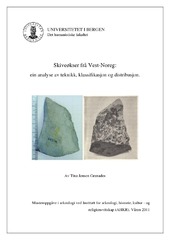| dc.description.abstract | Flake axe assemblage from the Western coast of Norway, an interpretation of technique, classification and distribution. The aim of this master thesis has been to present an analysis of the flake axe assemblage from Western Norway. With technique, classification and distribution as research-areas, several points have been made. A system of symmetrical classification presented by Troels-Smith from 1937, has been used and modified by later researchers as a result of investigating different flake axe assemblages, but also as a consequence of changing perspectives in archaeology. From the discussion presented in chapter 5. the symmetrical perspectives is questioned, but is further applied as a classification-tool for the flake axes of Western Norway. In addition to the symmetrical classification, both neck and edge are identified as important parts of the assemblage. The dynamic relation between flat- and side-edge trimming during reduction sequence, is also put forward as an important aspect of flake axe production. The total flake axe assemblage registered from the area of Rogaland to Sunnmøre (183 flake axes in total), is dominated by the symmetrical flat-trimmed flake axe, and thereby confirms earlier classification-work, conducted on both southwestern- and northwestern assemblages. A regional distribution-map of the flake axes in the research area, shows that the assemblage from the southwestern part of Norway evidently repeat the same image which has been presented in earlier research of flake axe-distribution, in northwestern part of Norway. Distribution shows that the area of utilization is confined to four concentration-areas. The landscapes can be defined as outer coast and outer fjord landscapes, with some exceptions. One flake axe specimen found approximately 600 m AMSL, interestingly gives flake axes as a technology, an additional landscape for utilization. Some specific aspects regarding interpretation of function has also been addressed. Dating and chronology has been discussed as a consequence of identifying flake axes made from grennstone. By understanding technology as an open door from which social structures and cultural concepts can be read, an attempt is made to portray the sequence of production for the flake axe assemblage. As a result a chaîne opératoire-model specific for flake axes located in Western-Norway, is presented. | en_US |
